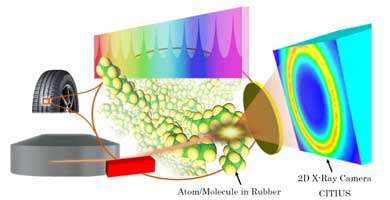 Japan’s Sumitomo Rubber Industries (SRI) had announced that it, in collaboration mainly with Makina Saito, Associate Professor at Tohoku University; Takaki Hatsui, Group Director at Riken; and Yoshitaka Yoda, Senior Scientist at the Japan Synchrotron Radiation Research Institute, has developed a new synchrotron radiation technique capable of measuring atomic, molecular, and nanostructure motion in a wide time domain including 1 nanosecond. Through this study, it will pursue the development of tyres with high strength and excellent wear resistance.
Japan’s Sumitomo Rubber Industries (SRI) had announced that it, in collaboration mainly with Makina Saito, Associate Professor at Tohoku University; Takaki Hatsui, Group Director at Riken; and Yoshitaka Yoda, Senior Scientist at the Japan Synchrotron Radiation Research Institute, has developed a new synchrotron radiation technique capable of measuring atomic, molecular, and nanostructure motion in a wide time domain including 1 nanosecond. Through this study, it will pursue the development of tyres with high strength and excellent wear resistance.
It adds it has conducted a joint study aimed at improving the wear resistance of tyres with Associate Professor Makina Saito of Tohoku University. With the conventional measuring technique, the firm was only able to measure atomic/molecular motion in rubber in a time domain of 10 to 1,000 nanoseconds. To improve wear resistance, it needed to examine atomic/molecular motion in rubber more closely in a shorter time domain.
Thus, the new synchrotron radiation technique it has developed this time is capable of measuring 0.1- to 100-nanosecond motion. Combining the innovative technique with conventional processes has made it possible to measure atomic or molecular motion in a wide time domain.
It has been developed using SPring-8, a large synchrotron radiation facility, for the first time. Furthermore, the use of CITIUS, the latest two-dimensional x-ray camera, has enabled the measurement not only the timescale of a moving object but its spatial scale at the same time.
SRI says it succeeded in measuring molecular chain motion in rubber in a wide time domain of 0.1 to 100 nanoseconds by applying the developed technique to rubber material (an article published in academic journal Physical Review Letters).
This study is carried out under CREST (Core Research for Evolutionary Science and Technology), one of the Strategic Basic Research Programs administered by the Japan Science and Technology Agency with the aim of promoting unique and world-class studies.
